Opinion
Why Conspiracy Theories Have Become the Most Influential Art Form of Our Time
Part 1 of a 2-part essay on art theory and conspiracy.
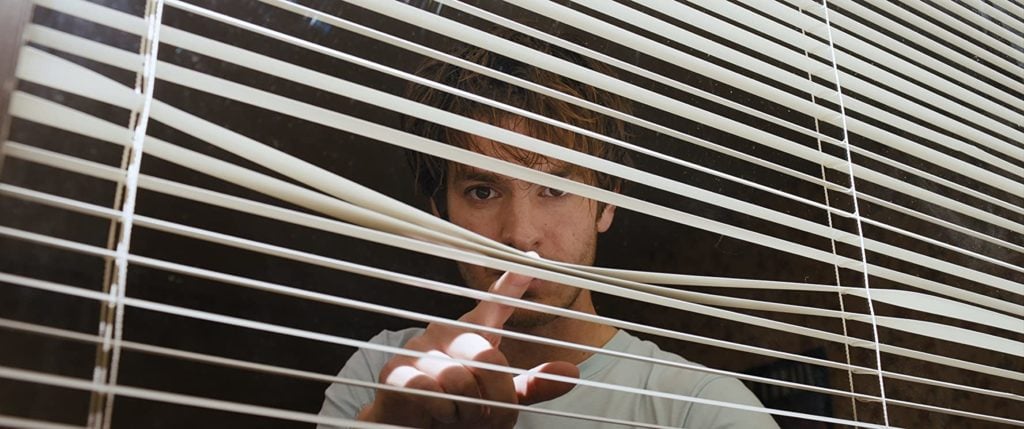
Part 1 of a 2-part essay on art theory and conspiracy.

Ben Davis

This is going to be a longer essay than I initially thought I’d write about conspiracy theory. It began in my head as me thinking about a few points I would have added to something I’d recently written explaining the unexpectedly virulent online conspiracy theory that the performance artist Marina Abramović is secretly at the center of a Satanic mind control plot.
But the more I thought about it, the more of these points I had, and the more they seemed to connect together as a way to explain the present. The subject, it seems to me, reveals itself to be more important the longer you look at it. The rabbit hole goes deeper and deeper.
The obvious reason the topic comes up right now will be clear to anyone who reads the news: conspiracy theories of various kinds are literally moving people into the streets right now. The recent wave of #ReOpenAmerica rallies were festooned with signs about QAnon and a coup plot against President Trump. Meanwhile, the president himself is promoting the idea that COVID-19 was deliberately released from a Chinese lab, and mobile phone towers are being attacked out of a belief that 5G internet spreads coronavirus.
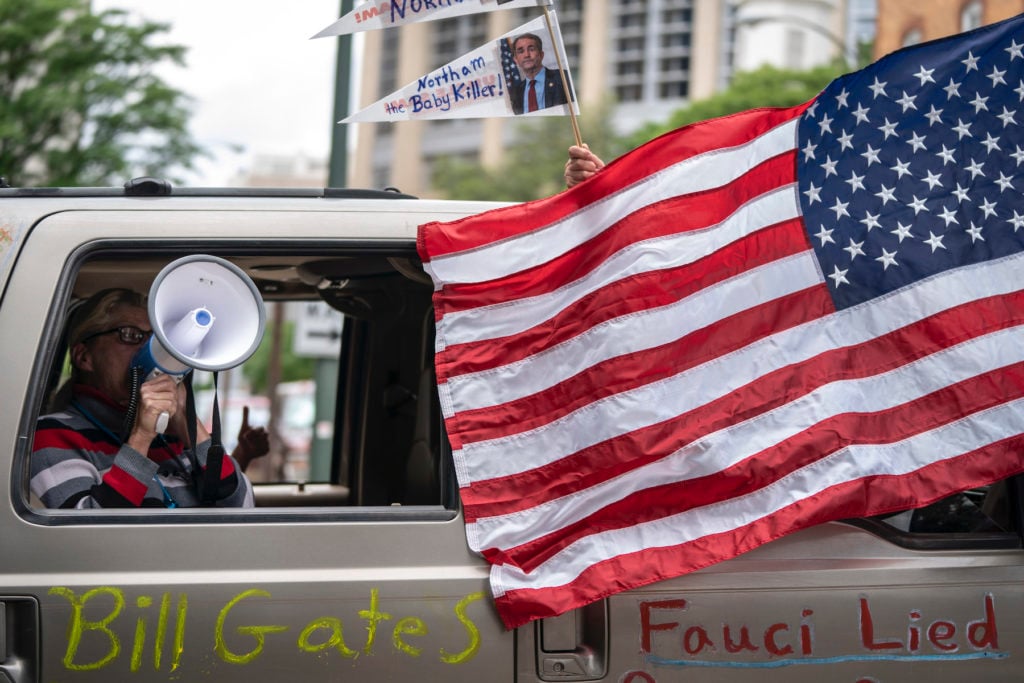
Protesters rally from their cars as they call for the state to lift stay-at-home orders and reopen the economy in downtown Richmond, Virginia near the State Capitol complex on May 6, 2020. Photo by Drew Angerer/Getty Images.
What accounts for the intensifying grip of conspiratorial thinking in the present?
“Conspiracy theory” is customarily a term used a bit the way people used to use the term “hipster”: always to dismiss someone else’s tastes, never to describe one’s own. This gives a kind of infinite regress quality to the attempt to criticize it, as if two mirrors have been placed facing one another: conspiracy theorists will argue that the term “conspiracy theory” itself was invented by the CIA to discredit seekers of the truth about the JFK assassination—a claim which, in turn, seems to be a conspiracy theory.
Starting out by emphasizing what is noxious, delusional, and outlandish in various “conspiracy theories,” it seems to me, only makes it more difficult to do the most important thing, which is to understand why they have traction in the first place. What I want to focus on here is how difficult it actually is to distinguish “conspiracy” thinking from some clear-cut “ordinary” way of thinking about the world. In fact, it may be that “conspiracy” turns out to be close to the ordinary way of thinking about the world; “non-conspiratorial” thinking may be actually the eccentric, fringe phenomenon in need of figuring out how to explain itself.
The Good, the True, and the Beautiful are the three classic “transcendentals” of Enlightenment thought. Whereas “conspiracy” thinking is often described as an irruption of the irrational, the place to start in understanding it is not its irrationality, but how it directly answers the hunger for each of these three cardinal values.
The Cold War liberal historian Richard Hofstadter is the go-to reference on this first, most obvious factor accounting for the intensification of conspiracy, via his 1964 essay “The Paranoid Style of American Politics.” There, Hofstadter charts how fantasies about Catholic cabals, Freemasonry, and foreign plots have been a deep, animating feature of US political life.
Sharp critics have pointed out problems with Hofstadter’s framing of the “paranoid style”: Chris Lehmann, writing recently in the New Republic, showed how his enduring popularity is due to how he conflates left- and right-wing populisms; in another register, Eve Sedgwick’s classic argument about “paranoid reading” damns Hofstadter for idealizing a rational political center-ground that does not exist.
But I appreciate the clarity of this line from Hofstadter’s famous essay: “[The] central situation conducive to the diffusion of the paranoid tendency,” he writes, “is a confrontation of opposed interests which are (or are felt to be) totally irreconcilable, and thus not susceptible to the normal political processes of bargain and compromise.”
This provides a credible mechanism to explain the rise of conspiracy in the present: as inequality has set record-busting extremes in the US, a variety of not-at-all radical commentators have declared that we live in an oligarchy rather than a democracy, given that the preferences of ultra-wealthy people and big corporations seem to rule our public institutions.
Out of Shadows, the wildly popular YouTube conspiracy film linking Abramović to Satanism I talked about in a previous piece, actually stops its speculations about MK-Ultra and Anton LaVey dead at a certain point to present a long clip of beatnik comedian George Carlin, a 2005 riff beloved by lefties.
It’s Carlin at his vulgar-street-preacher best, arguing that politics has been completely captured by money and that the system benefits from keeping people stupid. “They don’t care about you at all, you know—and nobody seems to notice, nobody seems to care. That’s what the owners want… It’s called it the American dream,” Carlin concludes, “because you have to be asleep to believe it.”
It seems clear that conspiracy theory gains plausibility as the gulf between the outward rhetoric of politics and the felt reality of how institutions actually function grows; antique national narratives about an “American Dream” seem to be doublespeak covering over some deeper and malicious reality; the fantasy space is thus ripe to fill up with all kinds of dark images.
To this political explanation, you can also supplement a second, epistemological explanation for the intensification of conspiracy thinking. This axis is what Marxist literary theorist Fredric Jameson explores in his 1992 book The Geopolitical Aesthetic, where he analyzes various forms of then-recent “conspiracy narrative” in film, from The Parallax View to Videodrome.
Essentially, what Jameson proposes is that high-tech, globalized capitalism has made the world more and more difficult for the average person to feel as if they adequately understand it. The forces governing lives are more and more difficult to comprehend using inherited explanations and traditional symbols. The food you eat, the products you buy—none have origins that can be connected to any community experience, and local reality is ever more governed by mysterious forces half a world a way. (The recently intensified consumer emphasis on recovering “local” production in food and crafts is, in this sense, another index of this same intensified alienation.)
The leaps of logic in conspiracy, in Jameson’s reading, are an attempt to recover a concrete narrative for a world that has grown too willfully complex to wrap one’s head around, offering “a narrative structure capable of reuniting the minimal basic components: a potentially infinite network, along with a plausible explanation of its invisibility.” Conspiracy makes an inscrutable world seem knowable. Instead of being adrift in a shifting sea of random, mysterious images and events, you have a master signifier of a plot that gives meaning to it all—and a corresponding sense of subjective power (of being able to interpret the world) and intellectual purpose (of teaching others that knowledge).
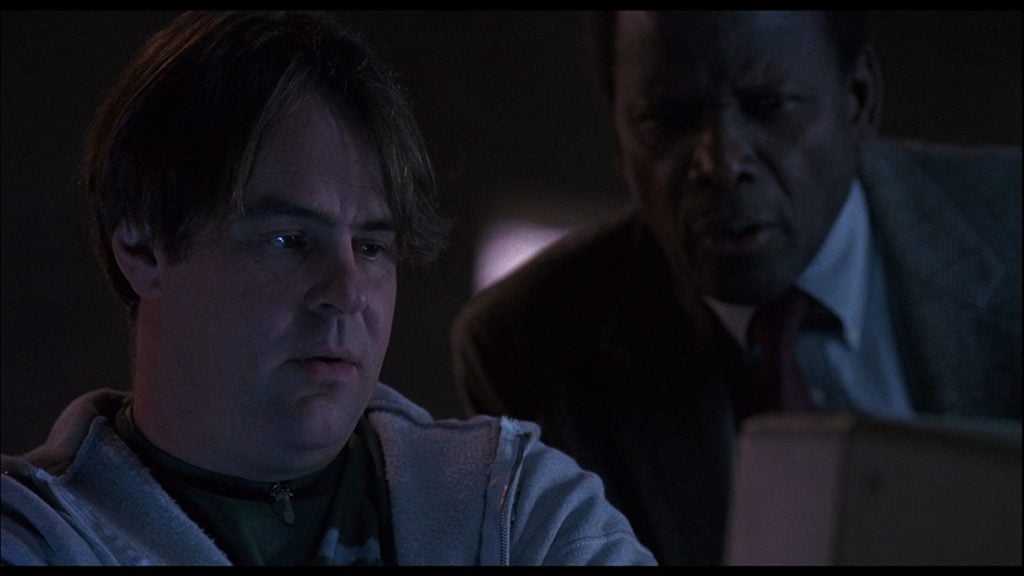
Dan Aykroyd and Sidney Poitier in Sneakers (1992)
(It’s interesting to note that in Jameson’s text “conspiracy theory” is not yet synonymous with “right-wing conspiracy” theory, so that he is able to be more sympathetic to the positive impulse behind conspiratorial thinking, as a kind of proto-systematic attempt to grasp the contemporary world. The Geopolitical Aesthetic came out the same year as the early cyber-thriller Sneakers, where Dan Aykroyd’s conspiracy-loving computer expert is an eccentric force for good. Compare him, 19 years later, to Jude Law’s evil blogger in Contagion, peddling fake cures and fomenting distrust in experts.)
The sheer mass of disconnected information in an internet culture makes simple—and simplifying—schemas to filter and navigate it all the more alluring, while the inner workings of digital technology are orders of magnitude more confounding than analogue technology to the non-expert, and so open to eliciting all kinds of superstitions. The cultural historian Mike Jay has even pointed out that increasingly inscrutable and invasive contemporary tech has more and more literally come to resemble the most fundamental images associated with clinical paranoia: invisible institutions monitoring your thoughts and desires and tweaking your reality to fit interests that aren’t your own.
Probably the most novel dimension we can consider, however—and the least explored and most thought-provoking—might be that conspiracy theory also serves a kind of artistic function. This is, perhaps, ultimately why bits of art tend to get pulled up into it so easily.
One theory of the very wide prevalence of conspiracy theory is that it relates to the natural aptitude of humans for identifying and making patterns. Spotting shapes in the clouds is an enduring symbol of creative imagination.
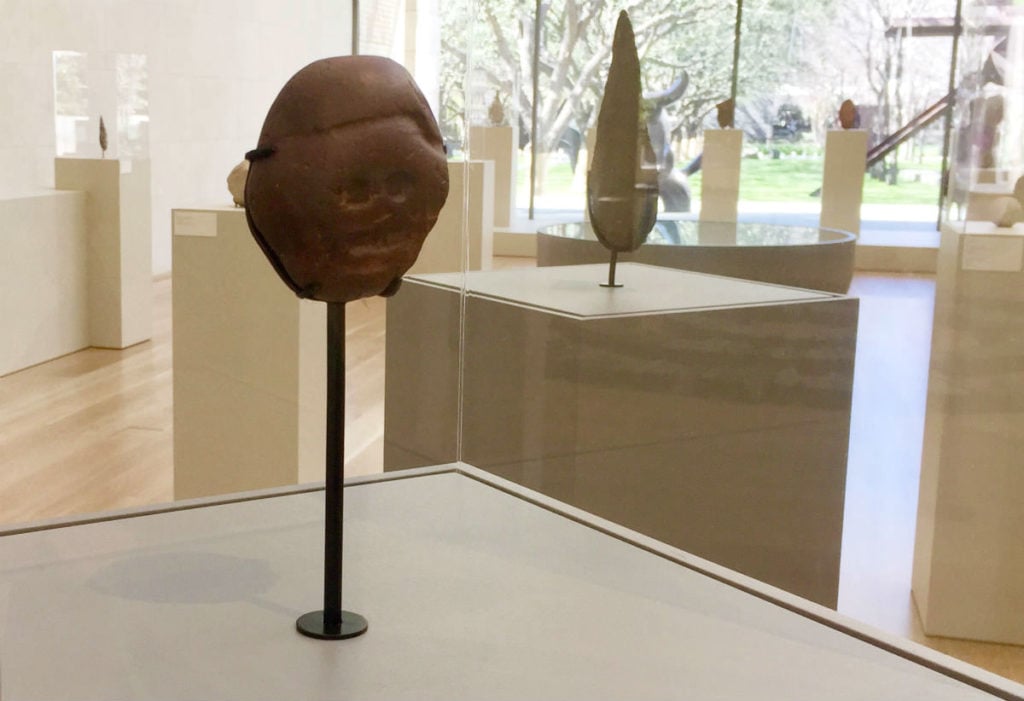
Installation view of the Makapansgat Pebble in “First Sculpture.” Image courtesy Ben Davis.
For that matter, the oldest kind of art-like activity, very likely, is not painting on cave walls but instead the way that our very distant ancestors would collect rocks in which they recognized the echo of human features. Recognizing patterns is a very primal skill for human survival, and pleasurable to show off. But as with, say, sex, the pleasurable side of the faculty can overshoot the utilitarian.
The natural activity of grouping together elements to form a picture may become the conspiracist cliché of “connecting the dots” to find the secret plot that makes a satisfying pattern of a disordered reality.
Reckoning with this last, aesthetic dimension of the phenomenon helps account for a notable feature of conspiracy thinking: the fact that, as if in some kind of reversal of Occam’s razor, its theories tend to be likelier to thrive if they are elaborate and outlandish, rather than simple and logical. They are, for this reason, very nearly impervious to mockery, and constantly cross over from fiction to reality in a way that can be hard to keep track of, let alone argue with.
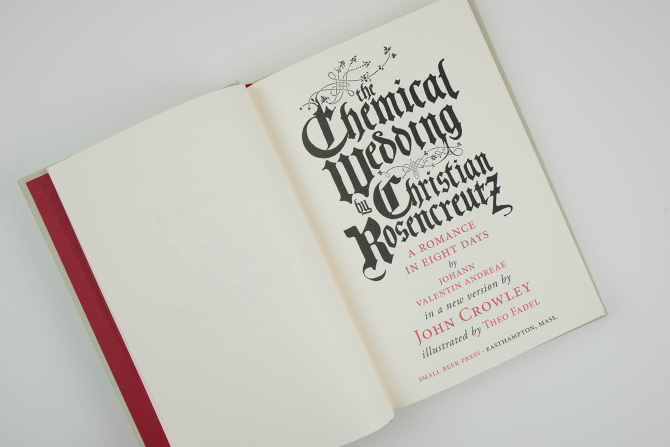
The Chemical Wedding: by Christian Rosencreutz: A Romance in Eight Days by Johann Valentin Andreae in a New Version, edited by John Crowley (Small Beer Press, 2016).
In some accounts, the ur-conspiracy fantasy of a secret order, the Rosicrucians, was birthed as a piece of proto-science fiction (The Chymical Wedding of Christian Rosenkreutz of 1616) and may even have been an attempt to mock the era’s other obsessions with secret societies—before then taking on a life of its own as both an actually believed alchemical doctrine and a phantasm of evil puppet-masters.
One of the earliest internet-era conspiracy theories, “Ong’s Hat” (look it up) also began as an online art project by Joseph Matheny. It took on an eerie life of its own, and despite Matheny’s later protestations that the project was born as an attempt at culture jamming—hoaxing the media so as to make people second-guess the narratives they are consuming—there are those who still believe this is all part of the cover-up of a secret world of parallel dimensions. (Some have alleged that the origins of QAnon are a similar kind of prank, though, as I’ve said, I don’t believe this.)
Conspiracy is flamboyant and colorful and involves leaps of imagination—and for that reason it makes life seem, not just righteous (as in the political explanation) and meaningful (as in the epistemological explanation), but also exciting. Though generally unvoiced, this thrill is clearly part of its traction, particularly where available mass culture is stripped of meaning by hyper-commodification.
Conspiracy clearly has the appeal of being in on a secret language, of finding symbolic community with others. Anyone who’s ever been a teenager drawn to something precisely because their parents hate it understands that the outrageous, the weird, even the offensive can actually be virtues when it comes to subcultural cachet, helping carve out a sense of stable, independent identity.
In the underrated 2018 conspiracy-comedy-noir Under the Silver Lake, you follow Andrew Garfield’s unemployed LA fail son Sam as he begins to believe that a spooky comic book has important messages hidden in it. The quest slowly leads him down more and more fevered and sociopathic paths. It becomes harder to tell what’s real from what’s imagined.
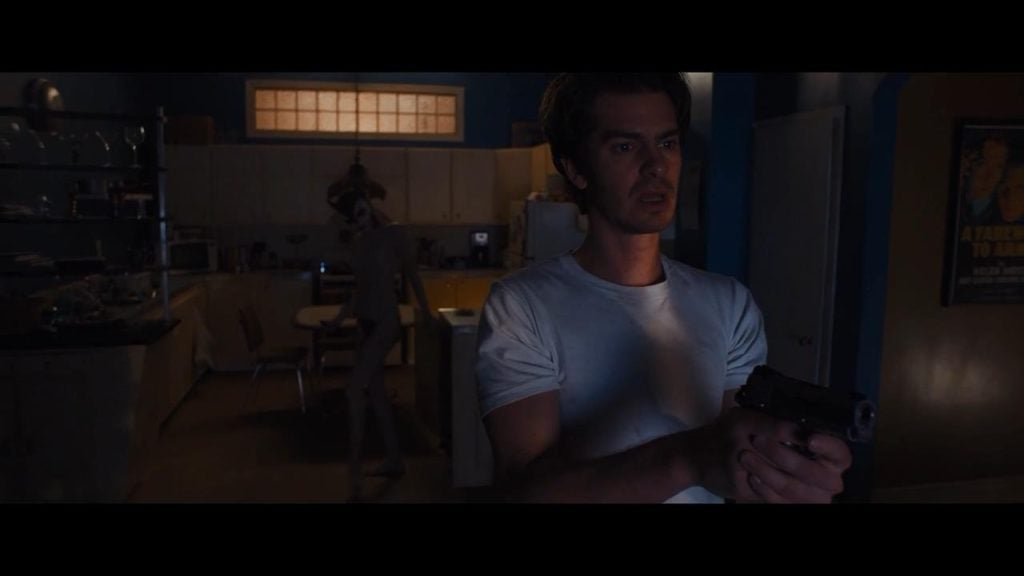
Andrew Garfield in Under the Silver Lake (2018).
The film has a lucid dream quality to it, but my mind returns to one scene as laying out a thesis about conspiracy rather clearly.
“You ever feel like you fucked up somewhere a long time ago?” Garfield’s Sam wonders aloud while sharing a beer with a friend on a directionless evening. “That you’re living the wrong version of the life you’re supposed to have? I used to think that I was going to be someone people cared about, maybe do something important.”
His friend dismisses the sentiment as normal.
“I feel like somebody’s following me,” Sam confesses abruptly—and you see in that moment the pivot between reality and fantasy.
Going “through the looking glass” is a conspiracy cliché, but the metaphor works: you can say conspiracy reflects the reality of economic disconnection, existential confusion, and of being unmoored from any appealing narrative of self-development—but as with any reflection, it involves a reversal. The idea of being at the center of a plot flips a sense of abandonment and disconnection into the very thing that makes you special and worthy of attention.
But here I’ve already slipped into talking about conspiracy as a false mode of thinking again, when what I’m trying to emphasize overall is how difficult it is to disentangle conspiracy from ways of thinking and impulses that we respect and even exalt. What the difficulty of definitively drawing this line means is something I’ll talk more about in the second part of this essay.